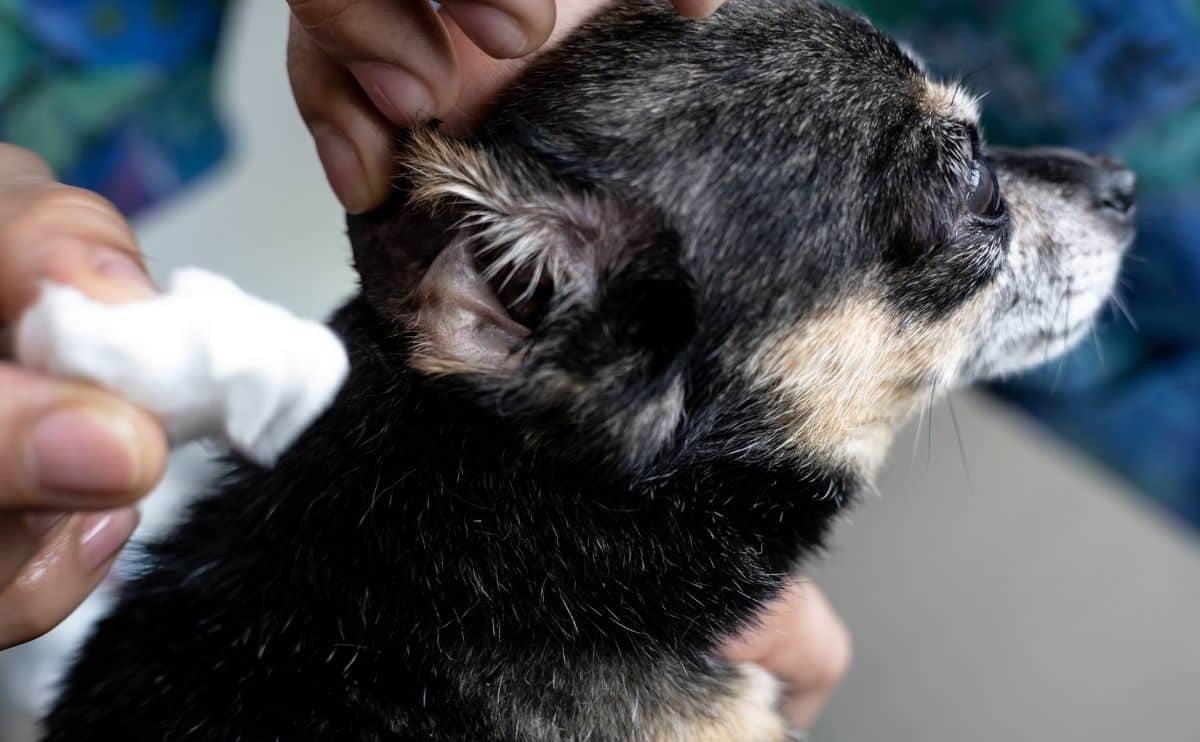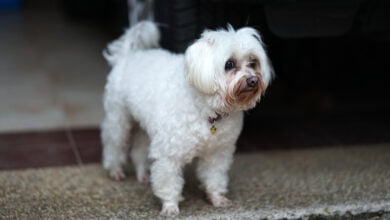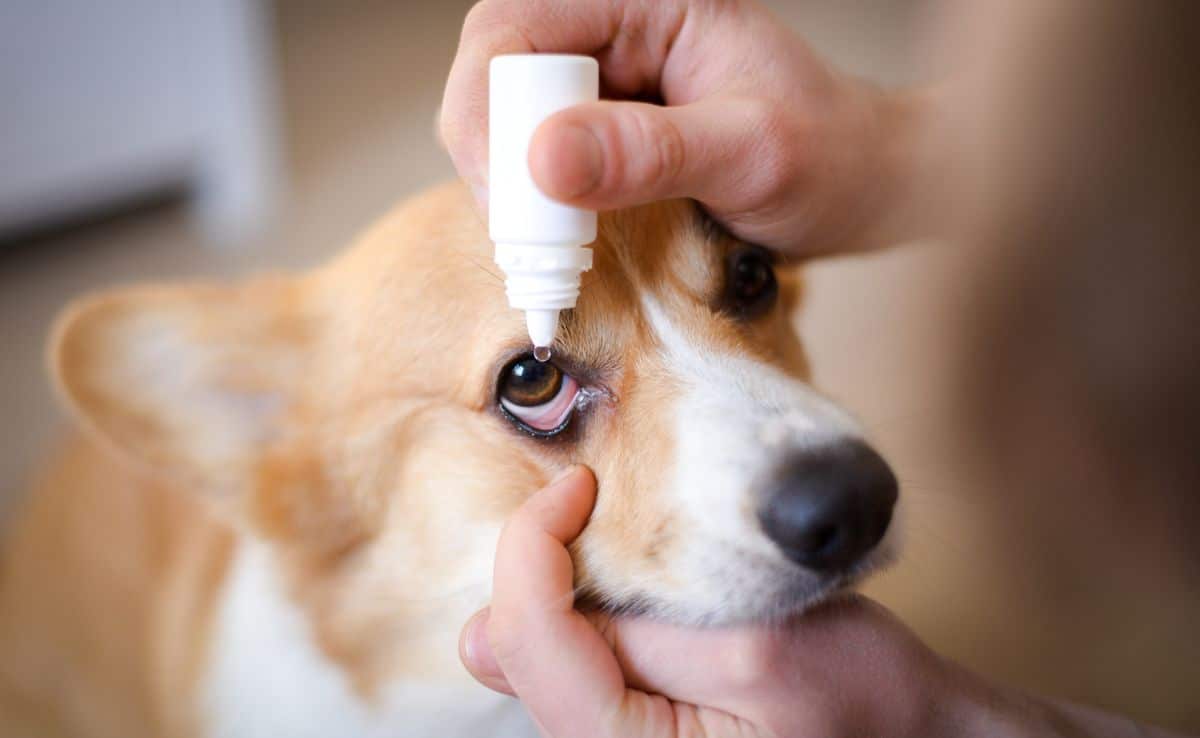5 Steps To Brushing Your Dog’s Teeth (A Complete Guide)
When you purchase through links on our site, we may earn a commission. Here’s how it works.

After a long day, what dog parent doesn’t love the joyful welcome they receive from their beloved pets when they walk in the door? But when you bend down to greet your happy hound, does their bad doggy breath make you cringe? That stinky smell could be more than just a sign that Fido ate something he shouldn’t have. Often, bad breath, just as for humans, is a sign that your dog’s dental health is not what it should be. So, what does a responsible dog owner do? Your dog’s oral health is important beyond just ridding your life of stinky breath. Let’s get into how to brush your dog’s teeth.
Table of Contents
Do You Really Need To Brush Your Dog’s Teeth?
Many doggy owners often ask, “Do I really need to brush my dog’s teeth?” Can’t I just give them a dental chew or rawhide to clean their teeth? While the occasional dog chew is a good idea if given responsibly to your pup, regular brushing is still required. Veterinarians strongly recommend it daily to prevent dental disease.
Luckily for dogs, they aren’t as prone to cavities as humans. However, according to VCA Animal Hospitals, more than two-thirds of dogs over three have some form of active gum disease, making it the most common disease in pet dogs. Dogs also love to eat things they shouldn’t, like poop, or household objects, which can impact their breath and oral health.
What Is Periodontal Disease?
Just like us, our pets can develop periodontal disease when plaque from bacteria builds up on and around their teeth (cue toothpaste commercial music). If you don’t remove this plaque, it gets hard and turns into tartar. Tartar, a calcified matrix of plaque and bacteria, irritates and inflames your doggie’s gums and can cause anything from mild gingivitis to advanced periodontal disease.
Without intervention, all of this can lead to severe pain for your dog, tooth loss, abscesses in their mouth, and/or bacterial infections that can spread throughout the bloodstream to the kidneys, liver, heart, or brain. Unfortunately, periodontal disease is irreversible, but prevention is possible with regular dog teeth cleaning.
From The Veterinarian
I spoke with Dr. Hannah Godfrey, BVetMed MRCVS, a small animal vet, to get a veterinarian’s perspective on brushing a dog’s teeth. “Dental periodontal disease comes into play when bacteria build up on your dog’s teeth surface and under the gumline. The gum and other soft tissue supporting the tooth become inflamed and infected, and the gum starts to recede over time. As the gum recedes, more and more of the tooth root is left exposed.”
Dr. Godfrey adds, “Periodontal disease is painful for your pooch and can lead to tooth loss and even life-threatening infection. Not only this, but bad teeth can also cause your pooch to have bad breath. So, if you’ve been trying to dodge kisses from your furry friend, or you’ve stopped enjoying cuddles with them, they could have bad teeth (or something worse).”
She explains, “When you brush your dog’s teeth, it disrupts the biofilm of bacteria that coat each tooth. This biofilm eventually leads to the formation of plaque and tartar. So, brushing frequently prevents the onset of dental disease, meaning your pooch is not in pain and can hang on to their gnashers for as long as possible. Dogs’ teeth don’t clean themselves (and they can’t), so it’s up to us, as responsible pet parents, to help prevent dental disease and plaque buildup on their teeth with a regular oral cleaning regimen.”
How To Brush Your Dog’s Teeth: 5 Simple Steps
The best advice is to take it slow and always reward your canine after so that they know good things come from having their teeth brushed. If you are a puppy owner, you can get your dog used to this new routine early. If you have an older pup, you can still work this into your overall care regimen for your pet.
1. Get Your Dog Used To Your Finger In Its Mouth
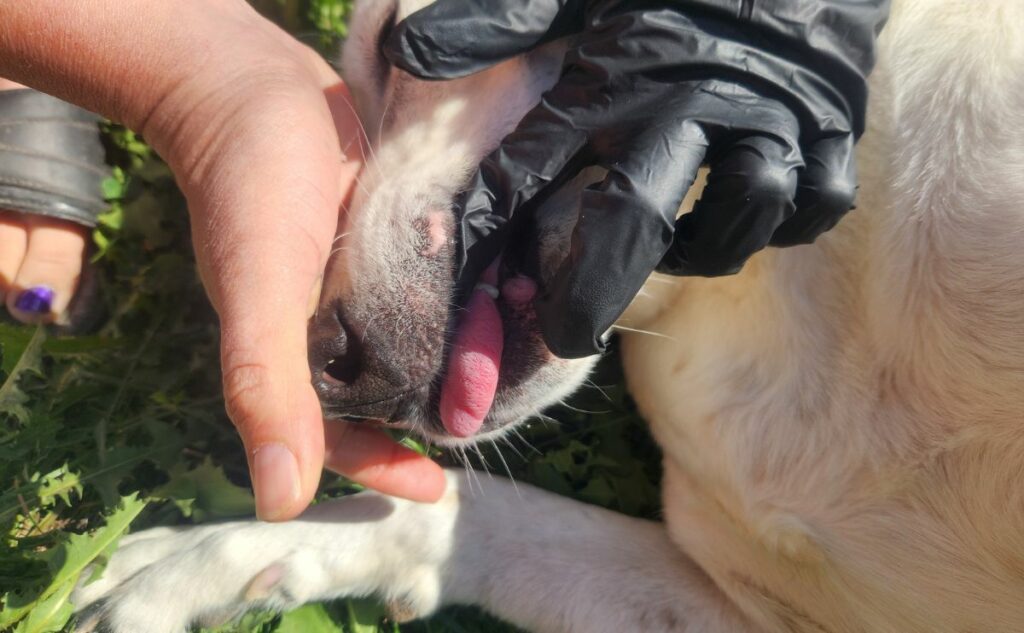
Before using a brush or paste, you need to teach your dog that it can be fun to have your fingers in his mouth. Dip your finger in something like peanut butter (or anything else they like) and let your dog lick your finger. As they do this, gently rub your finger along the sides of the teeth and gums. Gently lift their lips as you would when brushing.
Repeat a couple of times a day for 2-3 days. Towards the end of the process, introduce the doggie toothpaste you have chosen (do NOT use human toothpaste) to get them used to the smell and taste.
2. Open Your Dog’s Mouth
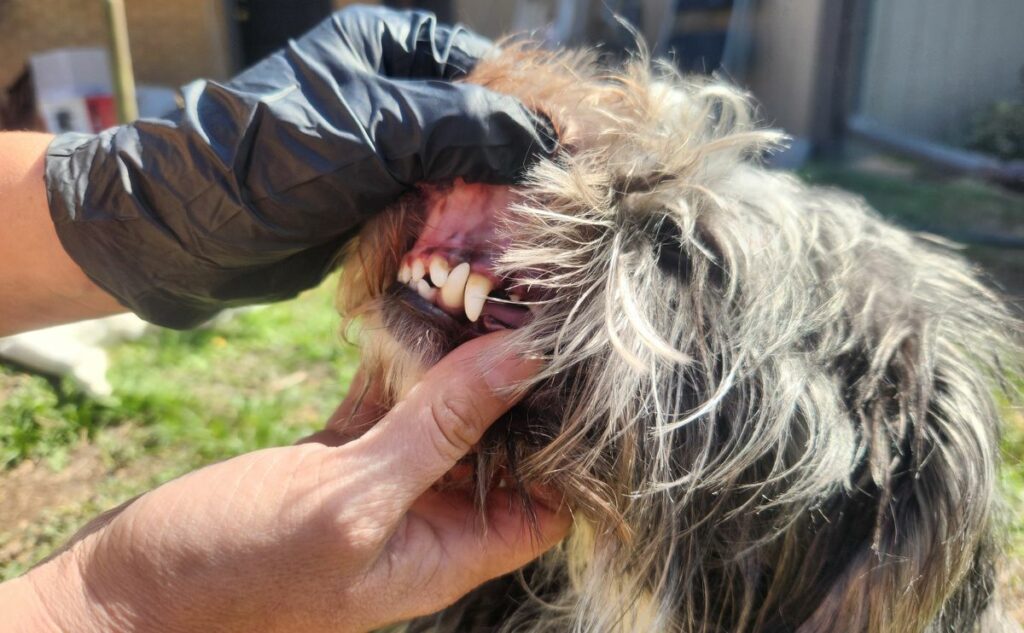
When your dog is comfortable with your fingers in his mouth, you can move on to teaching him to accept you opening his mouth. Make sure you have lots of treats on hand as positive reinforcement.
Gradually work up to opening his mouth for just a few seconds, increasing the time slowly. Always reward with treats and do this 8-10 times a session over several days.
3. What To Do If He’s Fighting You
If your dog struggles during these exercises, gently but firmly continue to hold his muzzle until he stops. As soon as he stops struggling and holds still for one second, release his muzzle.
You may have progressed a little too fast, so go back and practice the previous steps for a few more days. Try moving to the next step again when he seems comfortable at that step for two or three days.
4. Brush Teeth
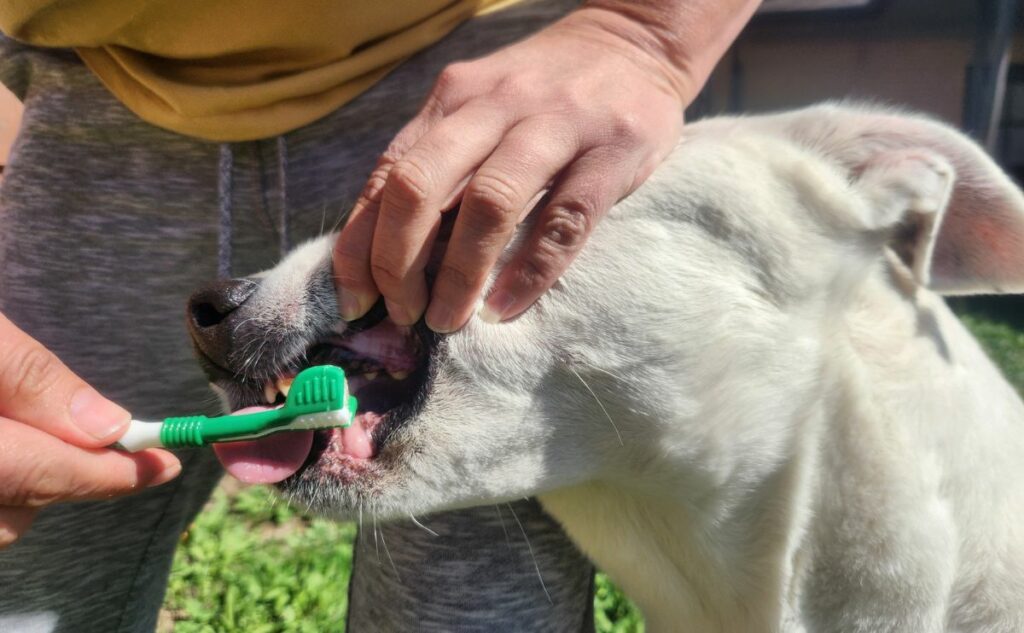
Once you have gotten him used to you exploring his mouth and moving your fingers along teeth and gums, you can move on to brushing. Start with a finger brush if your pup is a smaller breed or is slower to adjust to having his mouth manipulated. Make sure that you start slowly once again and increase the time over days. Dogs have 42 teeth, so make sure to get them all. We’ve reviewed several options if you need guidance on what dog toothbrush to use.
When you brush each tooth, use up and down motions, and try to make sure you cover the entire surface of the tooth rather than just the side facing you. Although the front side is more important. It’s also worth focusing on the gumline itself. However, you should take care because this area might be tender if your dog has gingivitis.
5. Reward
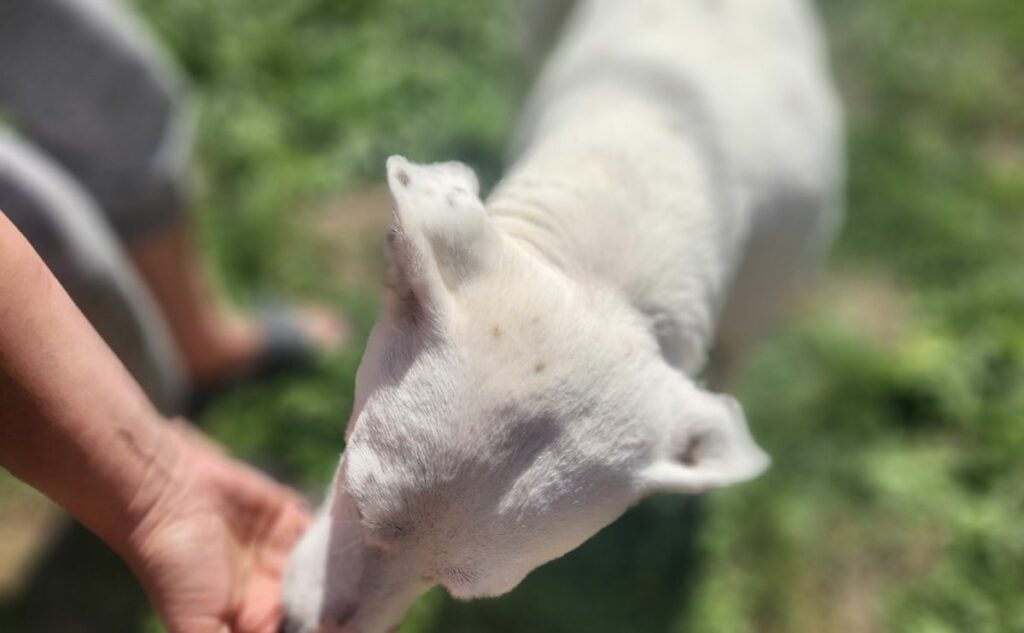
Again, always follow with favorite treats so that your pup is happy to let you brush his teeth.
Check out this video that recaps the steps above.
Which Products Should I Use?
There are many options for brushes and toothpaste out there for pups. Always pick something that is designed for a dog. From toothbrushes that look like they are for humans to finger brushes, find one that fits comfortably in your dog’s mouth and has soft enough bristles not to irritate their gums. You may want to consider a double-sided dog toothbrush like the Vetoquinol Enzadent Dual-Ended.
Doggie toothpaste comes in many flavors, including liver, mint, chicken, and peanut butter. But remember, NEVER use human toothpaste for a dog. Although your pooch may love the taste of mint, most human toothpaste has higher levels of fluoride in it. Your dog can develop fluoride toxicity much quicker than a human. Also, most human toothpaste has salts, detergents, and baking soda, all of which can harm your dog’s teeth.
If you are not sure where to start, we recommend the Nylabone Advanced Oral Care Kit (View on Amazon).
How Often Should I Brush My Dog’s Teeth?
Dogs eat every day, and just like humans, it would be ideal to brush your pup’s teeth after every meal. In the real world, many of us would never have the time for this. Once a day is the best recommendation for brushing their teeth, but if your schedule is still tight, aim to brush several times a week. Try to brush for at least 30 seconds per side of their mouth during each session.
One important thing to note is that smaller dogs and pups with flat or short broad snouts (i.e., pugs, bulldogs, etc.) often require more frequent brushing. Because of their smaller mouths, these dogs’ teeth are more crowded together. They are more prone to plaque build-up and thus more likely to develop periodontal disease. Learn more about how often to brush in this video from Pets Best Insurance:
Tips For Brushing Your Dog’s Teeth
- Start sooner than later with brushing your dog’s teeth. The sooner you start, the healthier their teeth will be throughout their whole life.
- Regular annual vet exams that include a dental check-up are a good idea.
- Hard dog food is better than soft daily and occasional chew treats (given under owner supervision). But don’t give your pup natural bones because they’re hard enough to fracture teeth.
- Do not try to overpower your furry friend or punish him if he resists tooth brushing. Forcing him to submit will only make him more reluctant to let you brush his teeth—and it might even cause defensive aggression. Instead, slowly and gently accustom your dog to tooth brushing.
- If you need help learning how to brush your dog’s teeth, you can always consult a Certified Professional Dog Trainer to help you.
- If you feel your dog needs a more intensive cleaning, take them to a professional veterinarian with the right training and properly administer anesthesia. Your pooch will thank you in the long run.
Frequently Asked Questions
I know there are plenty of questions about brushing your pup’s teeth, so I’ve answered some of the most common ones below. Let me know in the comments if you have a question I missed.
When Should I Start Brushing My Dog’s Teeth?
You can start brushing as soon as they will tolerate it, which can be as young as six or eight weeks old. Be careful when they are teething because their gums are very sensitive and sore. Keep it gentle. Starting young helps your pup get used to having their teeth brushed, and it helps them tolerate it better as adults.
Can I Floss My Dog’s Teeth?
Flossing your dog’s teeth is not recommended. Attempting to floss your dog’s teeth is difficult and likely involves wrangling them. This battle is likely to lead to injury or ingestion of the floss. If your dog swallows the dental string, it could get tangled up in the intestines, creating a potentially fatal situation.
I recommend this flossing rope, but only as a toy. Rope toys also present a risk of intestinal blockage if swallowed, so if you decide to give one to your dog, be sure to watch them closely.
How To Brush Your Dog’s Teeth When They Won’t Let You?
Brushing your pup’s teeth is no easy task. It takes time, patience, and lots of practice. If your pup is super resistant, you may need to make it a two-person job. One to hold your pup calmly, and the other to take care of the teeth. One thing that can be very helpful is to start small. Massage the lips a little and be very gentle. Work on one section at a time, keep the brushing session short and offer treats when the brushing session is over.
If your dog simply won’t let you brush, you can try alternatives. While they are less effective than brushing, you can also work with a system like BARK Bright Dental. I use this with my dog, and it works really well. You can also make sure to feed your pup dry kibble, as it helps scrape off plaque and buildup. Dry kibble helps reduce dental disease and promotes oral health. Some foods are even formulated and designed to help cause friction and remove plaque from the teeth.
Other products like antibacterial doggy mouthwash and gels that fight infection on the teeth are also helpful if you can’t brush.
What If I’ve Never Brushed My Dog’s Teeth?
It’s not too late to start, even if you have never brushed your dog’s teeth. Unbrushed teeth can develop a build-up of plaque that turns into hard tartar, which is very tricky to remove. Tartar can cause gum irritation and lead to periodontal disease. So, even if you’ve never brushed Fido’s chompers, it’s time to start! Plus, you’ll see a massive improvement in their breath.
Pet Insurance Can Cover Dental Issues
Unfortunately, even if you’re diligent with brushing your dog’s teeth, they could still be diagnosed with periodontal disease or require teeth removal. Some pet insurance providers cover these types of dental issues. You can find the best dental insurance for your dog to ensure you have financial assistance should your dog experience an unexpected dental problem.
A Healthy Diet Boosts Oral Health For Dogs
A healthy diet boosts your pup’s oral health in several ways. Dry kibble helps clean the teeth. Dog foods that use real meats are healthier overall, and fresh fruits and vegetables provide antioxidants, which help with oral health. Fresh water is also key to keeping your pup’s hydrated and mouth clean. You should also avoid foods high in sugars, as they contribute to dental decay. Fresh food like carrots adds crunch and antioxidants and helps freshen breath. Mint and coconut oil can also help keep Fido’s breath fresh.
Why Trust Canine Journal?
Danielle has raised many dog breeds and is currently the dog mom to two rescue pups, Falkor and Daisy. She knows how hard it is to brush doggie teeth and has tried out over 20 teeth-brushing products and dental chews with her dogs. Danielle has a background in education and professional research, focusing on canine health. She works alongside a dedicated team at Canine Journal to bring readers the best information to better canine lives.
